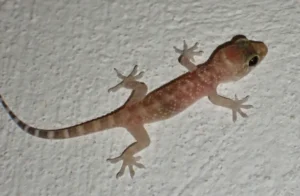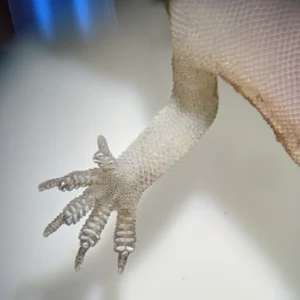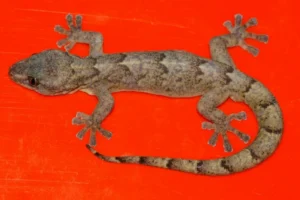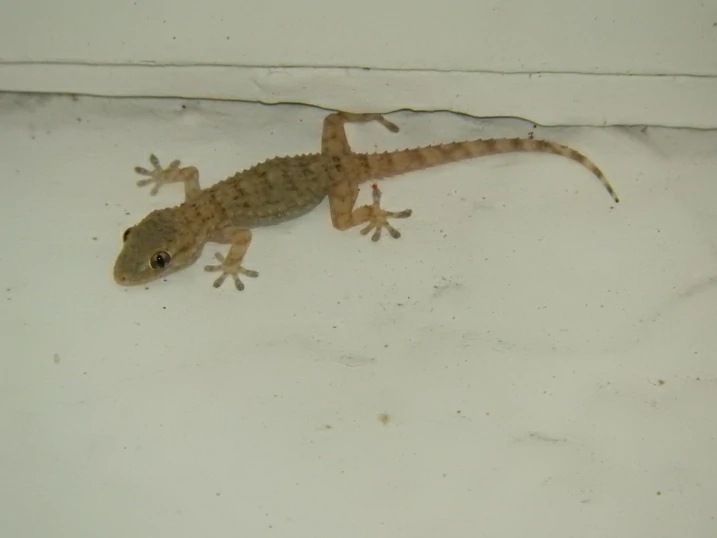You might have seen a little gecko dash across your wall or ceiling and thought, “Wait… if it falls, does it get hurt?”
It’s easy to assume a tiny lizard dropping from a branch or the ceiling would get injured. But geckos are actually some of the most surprising little acrobats in the animal world. So, do geckos take fall damage?
Most geckos don’t get seriously hurt from falls. Their unique body structure, flexible tails, and sticky toe pads let them absorb impacts from surprisingly high drops. In fact, many geckos can survive falls from heights several times their body length with no injury at all.
They’re not invincible, but they handle falls way better than you’d think.
That doesn’t mean you can toss a gecko across the room without consequences.
Height, surface type, and the gecko’s condition all matter.
Geckos Are Built For Falling… Sort Of
At first glance, geckos might look fragile. They’re small, often only a few inches long, and their bones seem delicate.
But their bodies are incredibly flexible, and that flexibility is exactly what helps them survive falls.
Unlike humans or most mammals, a gecko’s body can bend, twist, and spread out in midair, which helps reduce the impact when it lands.
One of the coolest parts of a gecko’s fall survival is their tail. The tail acts like a stabilizer and a little shock absorber.

When a gecko falls, it can use its tail to control rotation, balance its landing, and even slow its descent slightly. Think of it like a tiny parachute or a balance pole in gymnastics.
Some geckos can even drop their tail if needed, which distracts predators while they escape, though that’s more about evading danger than surviving a fall.
Their sticky toe pads are another big part of the story. These pads aren’t just for climbing walls and ceilings, they can help a gecko slow down or stick to a surface mid-fall, breaking the impact a little.

It’s not magic, it’s physics and biology working together. The microscopic hairs on their toes, called setae, let them grab almost any surface.
This means a gecko can land on a wall, tree bark, or even glass without injury.
How High Can a Gecko Fall?
You might be wondering: “Okay, geckos can survive a fall, but how high are we talking?”
The truth is, a lot higher than you’d expect. Scientists have seen geckos survive falls from heights 10–20 times their body length with no obvious injuries.
For a gecko around 4 inches long, that’s a drop of 3–6 feet, or even higher if they land well.
Part of this is because geckos are so light. Low weight means less force on impact, and their flexible bodies spread that force out.
They’re basically little bouncy balls that happen to have legs and sticky toes.
Humans, on the other hand, have more weight and rigid bones, which is why a fall from just a few feet can break an arm or worse.
Not all surfaces are equal either. Geckos handle falls onto soft or textured surfaces, like tree bark or soil, much better than hard, smooth surfaces like concrete.
So falling from a branch onto leafy ground is very different from dropping onto a patio or stone floor.
The Science Behind Gecko Landings
Researchers have studied gecko falls to figure out how they survive without getting hurt. One big discovery is that geckos don’t just flop down, they actively control their landings.
Even though they’re tiny, they can adjust their legs, tail, and body midair. This helps them land feet-first, absorb the shock with their legs, and even stick to walls or trees if needed.

Their muscles and joints are specially made for this. Gecko limbs are springy and flexible, bending and twisting on impact. Their joints can handle weird angles without breaking, which is key during a fall.
Imagine a little trampoline in each leg. When they land, it bends, absorbs the force, and bounces them slightly to reduce injury.
Some geckos even do a tiny “midair push-off” using their feet or tail to rotate and land safely.
It’s almost like they have a built-in skydiving instinct, and they use it without thinking.
When Falls Can Still Be Dangerous
Before you think geckos are invincible, there are limits. Most everyday falls are fine, but extreme heights or bad landings can still hurt them.
A gecko falling many stories onto a hard surface can break bones or suffer internal injuries, just like any other animal.
Young, sick, or injured geckos may struggle more with falls. And if a predator startles them and they fall awkwardly, survival can depend on luck and timing.
Their natural defenses are amazing, but not perfect.
Do Gecko Species Matter?
Yes! Not all geckos are equally good at surviving falls. Arboreal geckos (those that live in trees) are the real acrobats.
They have extra-flexible limbs, long tails, and specialized toe pads that let them stick to almost any surface.
Ground-dwelling geckos don’t fall as often, so their bodies aren’t as adapted for big drops.

Species like Tokay geckos or crested geckos are famous for dropping from branches and landing without a scratch.
Leopard geckos, which mostly stay on the ground, can survive short drops but are more at risk from higher falls.
Geckos vs. Predators: Falling as a Survival Tool
Geckos’ ability to survive falls isn’t just for accidents, they use it to escape predators.
If a predator like a snake or bird grabs a gecko or scares it, the gecko can intentionally drop from a branch or wall to get away. Their flexible bodies and sticky toes let them land safely, scramble away, and confuse predators.
Some geckos drop their tail too, which twitches and distracts the predator while the gecko lands safely and disappears. It’s like a little action movie stunt built into their biology.
Can Humans Help or Harm Geckos During Falls?
If you have pet geckos or see them indoors, it’s natural to worry about falls from shelves, walls, or enclosures.
The good news is they’re usually fine, especially if the fall is just a few feet onto a soft surface. Still, a few precautions help:
-
Soft landing surfaces: Towels or substrate under high areas in tanks or rooms can reduce impact.
-
Avoid high smooth surfaces: Falls onto tile or concrete are riskier.
-
Safe climbing spaces: Make sure geckos have branches or ledges to grip.
Don’t stress too much. Geckos are surprisingly tough, but a little care goes a long way.
Examples of Geckos Surviving Falls
Some real-life examples are impressive.
-
Tokay geckos have been seen dropping from ceilings and landing on walls or floors without injury. Their sticky toes let them climb back immediately.
-
Crested geckos often leap from one branch to another in enclosures, absorbing landings gracefully every time.
-
In the wild, geckos fall 10–15 feet onto leafy ground and just scramble away.
It’s almost funny how easily they survive what would terrify most other animals.
Their body design makes these falls minor inconveniences instead of dangerous events.
Conclusion
So, do geckos take fall damage? For the most part, no, they’re tiny acrobats built to survive falls.
Their bodies are flexible, their tails help balance, and their sticky toes let them land safely on walls, ceilings, and branches. Falls several times their body length are usually no problem, and in the wild, falling can even be a clever survival trick.
That said, they’re not invincible. Extremely high drops, rough surfaces, or injuries can still hurt them.
If you keep geckos as pets, giving them safe climbing areas and soft landing zones is the best way to let them do what they naturally do, climb, jump, and even fall, without getting hurt.
Next time you see a little gecko plummet from a branch or ceiling, don’t worry too much.
Hi, my name is Ezra Mushala, i have been interested animals all my life. I am the main author and editor here at snakeinformer.com.

